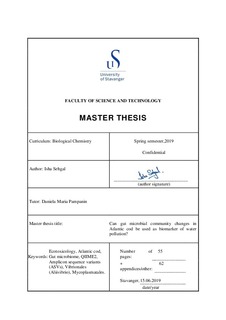| dc.contributor.advisor | Pampanin, Daniela Maria | |
| dc.contributor.author | Sehgal, Isha | |
| dc.date.accessioned | 2019-10-22T12:54:24Z | |
| dc.date.available | 2019-10-22T12:54:24Z | |
| dc.date.issued | 2019-06-15 | |
| dc.identifier.uri | http://hdl.handle.net/11250/2623753 | |
| dc.description | Master's thesis in Biological chemistry | nb_NO |
| dc.description.abstract | The gut microbiome of juvenile Atlantic cod (Gadus morhua) was studied to evaluate changes related to the exposure of dispersed crude oil and find potential biomarker of exposures. Fish was exposed to dispersed crude oil (0.05 ppm) for 1,3,7 and 28 days, as a reference a group of fish was maintained in the laboratory without oil exposure as a control group (n=4). Gut samples were dissected and stored at -80°C for analysis. Various DNA extraction methods were tested, to find the optimal conditions. The Illumina MiSeq platform was used for sequencing the V4-V5 region of the 16s rRNA gene.
The sequencing results were examined with the software- QIIME2 and the R package. An average of 359,912±183,643 quality filtered reads were generated and 3438 amplicon sequence variants (ASVs) were identified after data processing of 32 samples. A non-metric multidimensional scaling (NMDS) analysis based on Bray-Curtis distance matrix was done to understand the distribution of samples. Pielou’s evenness and Shannon indices were used for diversity analysis. The taxonomy study revealed that the most abundant orders in the juvenile Atlantic cod gut were Vibrionales, Mycoplasmatales, Actinobacteridae, Alteromonadales, Rhodobacterales and Pseudomonadales. DESeq2 analysis depicted upregulation of 9 and downregulation of 65 ASVs.
From the obtained data, it was possible to conclude that the dispersed crude oil exposure promotes changes in the gut microbiota and affects their diversity. At the order level of classification, Vibrionales (Aliivibrio) and Mycoplasmatales seem to be indicative of exposure to the oil contamination. The present thesis work is building on the current knowledge base in this area of study and data generated is regarded value addition for future research. | nb_NO |
| dc.language.iso | eng | nb_NO |
| dc.publisher | University of Stavanger, Norway | nb_NO |
| dc.relation.ispartofseries | Masteroppgave/UIS-TN-IKBM/2019; | |
| dc.subject | ecotoxicology | nb_NO |
| dc.subject | Atlantic cod | nb_NO |
| dc.subject | gut microbiome | nb_NO |
| dc.subject | QIIME2 | nb_NO |
| dc.subject | biologisk kjemi | nb_NO |
| dc.subject | biokjemi | nb_NO |
| dc.subject | biochemistry | nb_NO |
| dc.subject | mplicon sequence variants (ASVs) | nb_NO |
| dc.title | Can gut microbial community changes in Atlantic cod be used as biomarker of water pollution? | nb_NO |
| dc.type | Master thesis | nb_NO |
| dc.subject.nsi | VDP::Mathematics and natural science: 400::Basic biosciences: 470::Biochemistry: 476 | nb_NO |
